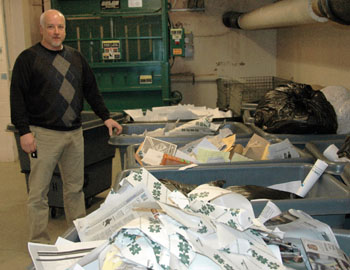By Beth Petrowske

Greg VanderVeer, Central Office Facility Management Unit and recycling coordinator, stands next to recycling bins full of paper. Cardboard, paper, aluminum and plastic are picked up weekly from Central Office and sent to the State Recycling Center on Grove Street in St. Paul. Photo by Beth Petrowske |
In 2009, Central Office recycled nearly 145,000 pounds of paper, cardboard and beverage containers. Although the number reflects a substantial amount of recycled material, CO disposed of nearly 155,000 pounds of solid waste, meaning only 48.3 percent of all solid waste generated was recycled.
“All state agencies are required by law to recycle 60 percent of the solid waste they generate,” said Greg VanderVeer, Central Office Facility Management Unit and recycling coordinator. “Going forward, all of us need to be a little more conscientious in our recycling practices so we can meet that 60-percent mark.”
The Department of Administration has provided an outline on their Web site of items that can be recycled. Employees who need recycling containers for their office can contact Greg VanderVeer at 651-366-3047.
“Recycling containers are available at no charge from the Department of Administration,” VanderVeer said. “The Department of Administration can also provide great recycling ideas and options to Mn/DOT employees over the phone or during onsite informational meetings.”
Mn/DOT Districts are also required to reach the recycling goal of 60 percent.
Recycling efforts continue to decline
Central Office recycling amounts for the first quarter of fiscal year 2009, 2010
| Fiscal Year 2009 |
Fiscal Year 2010 |
| 37,385 pounds |
35,597 pounds |
How much energy is saved by recycling?
The amount of lost energy from throwing away recyclable commodities such as aluminum cans and newspapers is equivalent to the annual output of 15 power plants. The energy savings applies to all recycling sectors:
Aluminum—Recycling of aluminum cans saves 95 percent of the energy required to make the same amount of aluminum from its virgin source. One ton of recycled aluminum saves 14,000 kilowatt hours of energy, 40 barrels of oil and 10 cubic yards of landfill space.
Newsprint—One ton of recycled newsprint saves 601 kilowatt hours of energy, 1.7 barrels of oil (71 gallons), 60 pounds of air pollutants from being released, 7,000 gallons of water and 4.6 cubic yards of landfill space.
Office Paper—One ton of recycled office paper saves 4,100 kilowatt hours of energy, nine barrels of oil, 60 pounds of air pollutants from being released, 7,000 gallons of water and 3.3 cubic yards of landfill space.
Plastic—One ton of recycled plastic saves 5,774 kilowatt hours of energy, 16.3 barrels of oil and 30 cubic yards of landfill space.
Steel—One ton of recycled steel saves 642 kilowatt hours of energy, 1.8 barrels of oil and four cubic yards of landfill space.
Glass—One ton of recycled glass saves 42 kilowatt hours of energy, 0.12 barrels of oil (5 gallons), 7.5 pounds of air pollutants from being released and two cubic yards of landfill space. More than 30 percent of the raw material used in glass production now comes from recycled glass.
Source: Department of Administration |
|



